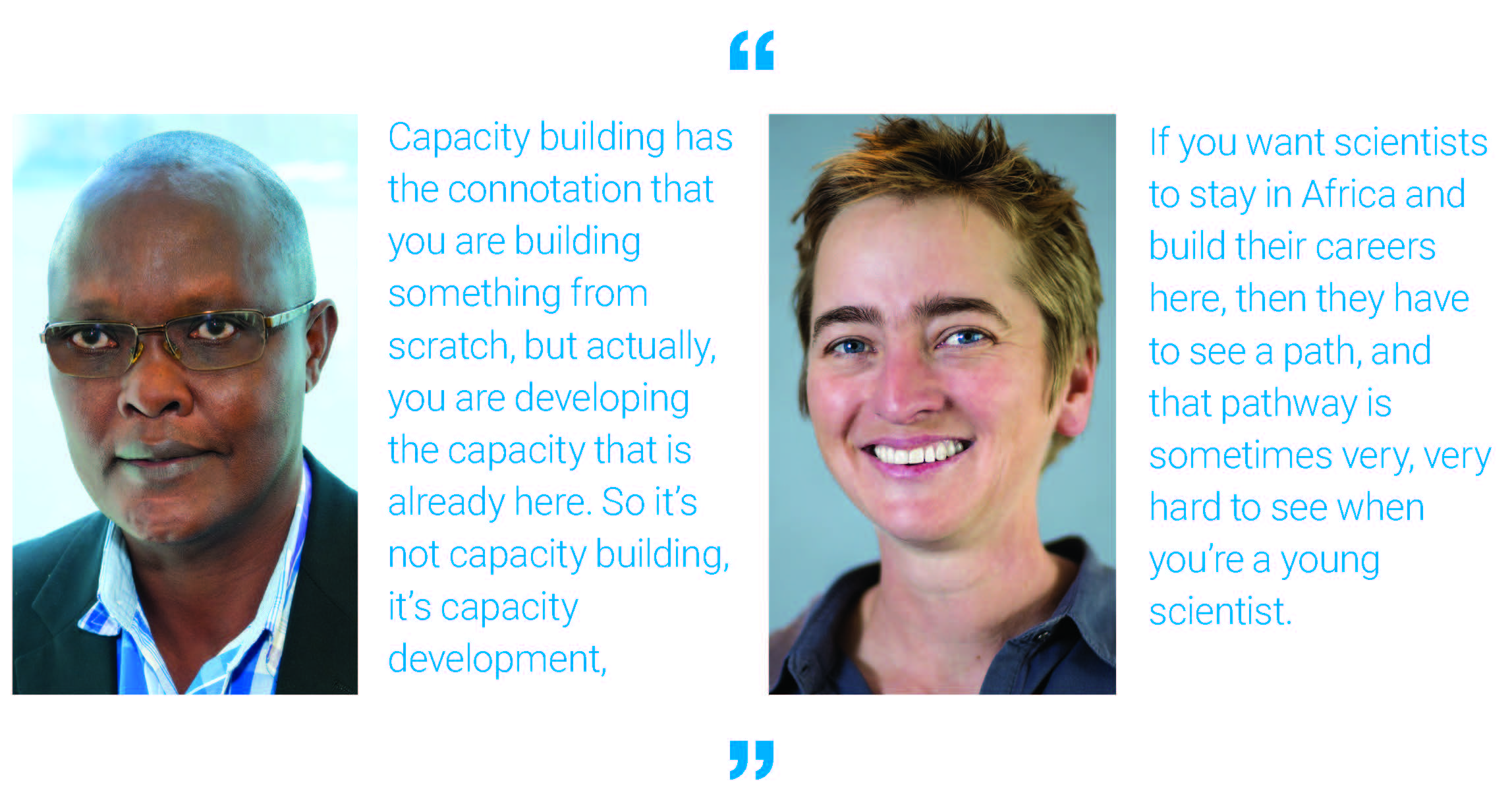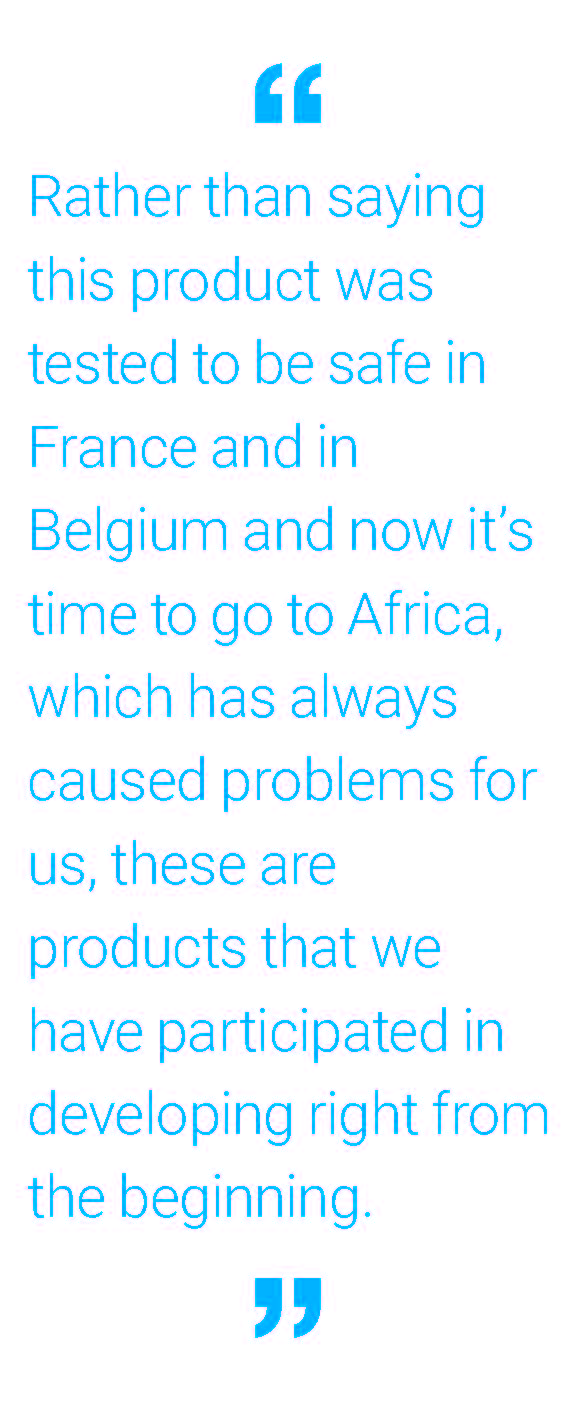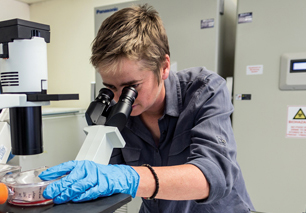November 22, 2019
‘We’re moving in the right direction’
A conversation with Anatoli Kamali and Penny Moore about the rise of HIV vaccine science in Africa
Kristen Jill Kresge
On a cloudy and cool evening in Lusaka in early February, I sat on an outdoor terrace talking with Anatoli Kamali and Penny Moore. The pair are witnessing first hand, though from different vantage points, the increasingly prominent role researchers and investigators in Africa are playing in the quest to develop an HIV vaccine.
though from different vantage points, the increasingly prominent role researchers and investigators in Africa are playing in the quest to develop an HIV vaccine.
Kamali is head of IAVI’s regional programs in Africa, and Moore is South African research chair of virus-host dynamics at the University of the Witwatersrand and the National Institute for Communicable Diseases. They were in the now verdant capital of Zambia for meetings on ADVANCE—Accelerate the Development of Vaccines and New Technologies to Combat the AIDS Epidemic— IAVI’s five-year program funded by the United States Agency for International Development (USAID), through the U.S. President’s Emergency Plan for AIDS Relief (PEPFAR). ADVANCE is now at its halfway mark, and the meetings in Lusaka were designed to both take stock of the program’s accomplishments and to plan for its future success.
For decades, USAID has fostered leadership among African scientists. This long-term support, funneled through IAVI to its network of partner institutions, began in 2001. It helped establish a network of clinical research centers in five sub-Saharan African countries and India. These clinical research centers are now actively engaged in basic science, epidemiological, and clinical research that is helping advance HIV vaccine design and development. USAID’s support also allowed IAVI to conduct large cohort studies of HIV-infected individuals in Africa that have provided some of the most useful clues for researchers who are working to design novel vaccine candidates.
The ADVANCE program, the latest iteration of the now decades-long partnership between USAID and IAVI, places an even greater emphasis on shifting leadership to African investigators, or as Kamali describes it, allowing the program “to be driven by Africans for Africa.” This involves further developing scientific research capacity on the continent by supporting young African scientists so they can become leaders in the global efforts to develop, test, and eventually implement a future HIV vaccine and other prevention strategies. Much of this work happens through ADVANCE’s Vaccine Immunology Science and Technology for Africa (VISTA) consortium.
The motivation for involving African scientists and populations in this work couldn’t be more obvious—Eastern and Southern Africa are still home to the largest number of people living with HIV, according to statistics from the Joint United Nations Programme on HIV/AIDS. There is arguably nowhere on earth that could benefit more from a long-lasting, highly effective vaccine.
ADVANCE is one of many ongoing efforts to cultivate promising African scientists. The Human Heredity and Health in Africa Consortium (H3Africa) is another example. This program aims to facilitate African scientists to conduct research into diseases on the African continent and to support a sustainable African research enterprise. There is a broad base of international support these days for public health and genomics research in Africa stemming from the support of various governments and organizations. There are also many terms used to describe the efforts to develop the scientific capacity of African researchers and institutions. The most common is probably capacity building. But, perhaps unsurprisingly, African researchers bristle slightly at this term.
“It’s almost, in a way, a depressing term,” says Moore. “It ignores everything that we have on the continent and all the successes we’ve had in the past. It is very well intentioned, but sometimes it’s slightly denigrating too,” though Moore acknowledges that South Africa is in some ways unique among sub-Saharan African nations. “South Africa is a little bit different because I think we have kind of a higher starting position in some respects.”
Kamali, a native of Uganda who oversees IAVI’s programs in Africa from its offices in Nairobi, Kenya, agrees that the term “capacity building” undervalues the significant intellectual resources and infrastructure that already exist across the region. “Capacity building has the connotation that you are building something from scratch, but actually, you are developing the capacity that is already here. So it’s not capacity building, it’s capacity development,” he says. “Whoever comes to Africa is finding the platform is already here, and they are just enhancing the capacity of individuals, institutions, and networks toward improving their capabilities to respond to their health needs.”
After decades of investment in developing the infrastructure, institutions, and human capacity to conduct scientific research in Africa, I asked Kamali and Moore how they measure the success of these efforts. “That’s a little complicated,” says Kamali. “There are traditional ways—number of people trained, number of Ph.D. candidates supported, number of post-docs trained—but they have their limitations.
 “There are several more objective ways to measure success, including the number of African scientists who assume leadership roles,” says Kamali. “The idea is that these individuals should be prepared to take over for the current generation that is leading research programs and institutions. We’ve trained these individuals and post-docs. The next measure of success is whether they will now be able to recruit and train another cohort of scientists themselves so that it is an effect that continues to build.
“There are several more objective ways to measure success, including the number of African scientists who assume leadership roles,” says Kamali. “The idea is that these individuals should be prepared to take over for the current generation that is leading research programs and institutions. We’ve trained these individuals and post-docs. The next measure of success is whether they will now be able to recruit and train another cohort of scientists themselves so that it is an effect that continues to build.
“Another measure of success is, of course, number of publications by African scientists in peer-reviewed journals, especially as first authors. I think that’s a very tangible measure.” Moore nods in agreement.
“Another is the number of grants that young African scientists apply for and receive as the lead grant holders. The other, which we keep talking about, is studies being led by African investigators.”
Earlier that day during the ADVANCE meetings, Eunice Nduati, a post-doc who studies B- and T-cell immune responses to early HIV infection at the Kenya Medical Research Institute Wellcome Trust Research Programme in the coastal town of Kilifi, Kenya, was asked how she defined success as an African scientist. Her answer was simple: “Success for a scientist in Africa looks the same as it does for a scientist anywhere. It’s the same things that define success.”
Moore wholeheartedly agrees. “I thought that was a brave and accurate response. They are the same measures of success,” she says. “We need to have African-led research grants that are sourced by Africans from international grant-funding bodies, and those really are the same measures of success that any young scientists in the U.S. would also aspire to,” Moore adds.
“I also agree with the point Anatoli is making that we want these students to turn into the next set of leaders and to develop their own research programs.”
Nduati currently holds a mid-career fellowship from IDeAL (the Initiative to Develop African Research Leaders), one of 11 of the Developing Excellence in Leadership, Training, and Science (DELTAS) Africa initiatives that are funded by the Wellcome Trust and the U.K. Department for International Development. She also is a part of the IAVI VISTA consortium, which is funded by USAID. Additionally, she has a grant from the sub-Saharan African Network for TB/HIV Research Excellence (SANTHE).
If you can wade through all those acronyms, you quickly realize that Nduati is one of the success stories. And she isn’t the only one. There are several others like her, a sign that the focus on developing the capabilities of African scientists and institutions is paying off. “If you want scientists to stay in Africa and build their careers here, then they have to see a path, and that pathway is sometimes very, very hard to see when you’re a young scientist,” says Moore. “Unless you have very generous mentors, it is sometimes hard to see how you can stay in Africa and do science. But now there are a lot of people finding that pathway. This has been happening for a long time, but I think it is certainly happening more now.”
Kamali acknowledges that there is still plenty of work to do to shift the balance to Africa, but the scientific progress on display from the young and mid-level HIV researchers suggests things are moving in the right direction. “We are not completely there yet, but I think that if we continue on the same track and at the same pace, we will get there.”
Part of what makes it easier for these young scientists to forge their careers in Africa today is the significant institutional capacity that has been strengthened over recent decades. The institutions, or, as they are sometimes referred to, centers of excellence on the continent, can now provide the support systems to conduct scientific research at the highest levels.
In a way, an individual’s success is dependent on the institution’s success. “I suppose institutional success is creating a system so that a young scientist can look at the institution and know that they can shape their career there and be safe in knowing that when they need to buy reagents, the systems are in place, and when they need to apply for grants, they have grant managers to help with that. It is also knowing that grant-funding bodies like the Wellcome Trust are going to know that their facilities are good enough to manage the grants once they are awarded,” says Moore. “Those should be the least of your worries as a young scientist. Your worries should be coming up with the cool ideas and innovative science. Institutional success is what allows a scientist to focus on science.”
The improved institutional capacity not only helps retain young African researchers on the continent, it also draws some of them back. “Once the institutional capacity has been developed, then you start seeing those institutions attracting African scientists from Europe and America back to Africa. It actually reverses brain drain,” says Kamali. “But that can only be achieved when African institutions meet a certain level and scientists can access everything they need to be able to do what they were to do if they were in the north.”
Another sign of institutional success is seen through South-to-South collaborations, which is when African institutions are partnering with each other or with institutions in India. “Much of the work is African institutions partnering with U.S. or European universities, which of course you can’t totally avoid,” says Kamali. “Nor do you want to avoid it,” Moore interjects. Kamali agrees. “But you also want to see these research consortia develop between African institutions that are sharing expertise.”
There is a reigning sentiment of optimism in the HIV vaccine field today (see “Overflowing with Antibodies and Optimism,” IAVI Report, Vol. 22, Issue 3, 2018). Much of this optimism is driven by the work on broadly neutralizing antibodies—those relatively rare proteins that are capable of inactivating many of the currently circulating isolates of HIV.
 Penny Moore, a Reader and South African research chair of virus-host dynamics at the University of the Witwatersrand and the National Institute for Communicable Diseases, in the lab in Johannesburg.
Penny Moore, a Reader and South African research chair of virus-host dynamics at the University of the Witwatersrand and the National Institute for Communicable Diseases, in the lab in Johannesburg. These antibodies allowed scientists to identify new targets on the virus that they can exploit in vaccine design, and have opened up the possibility of using broadly neutralizing antibodies directly for prevention, a strategy referred to as passive administration or antibody-mediated prophylaxis. “All of the people who’ve worked on all of these things for so long have always hoped that at some point we will be at the stage where the science drives the questions enough to be able to start testing things that we think might actually work,” says Moore. “It is the type of blue-sky science that has finally translated into something that I think will be useful. I don’t think we’re expecting a panacea, but both the active and the passive immunization arms are hugely exciting and promising. Time will tell.”
Based on work that originated with HIV-infected African volunteers, some of these vaccine approaches and passively administered antibodies are, or will soon be, returning to Africa to be tested in clinical trials (see The best is yet to come). The significance of this is not lost on any African investigator. “I think many other people have the same sense of satisfaction from seeing these approaches come back to be tested in Africa. For me, it is the culmination of many years of work.”
It turns out that this HIV vaccine and antibody work also has more than its roots in Africa. “A lot of the samples were collected here, that’s true, but beyond that, a lot of the great science was done in Africa, including defining how these antibodies develop and defining how common they are,” says Moore. “It’s much more than just the fact that we have these incredible cohorts that people have built up over many, many years.”
Now researchers on the continent are contributing in yet another way toward the quest to develop an HIV vaccine. “Many African scientists are also involved in understanding whether these trials are going to work, which I think is exactly the model that we want to see,” Moore says. “These antibodies and vaccines will be tested here and people in African countries will be measuring the immune responses and seeing whether these concepts will work. That’s exciting.”
The fact that this work involves African researchers from the start may also positively affect eventual acceptance of any future products that are developed, according to Kamali. “Rather than saying this product was tested to be safe in France and in Belgium and now it’s time to go to Africa, which has always caused problems for us, these are products that we have participated in developing right from the beginning,” he says. “These products, modified or otherwise, are coming back to the populations from the countries where they were first isolated. If we are eventually successful, I think it would be a unique and historical discovery to show that this work started with the communities in need and then these products came back, are tested, and eventually delivered to these same communities.”
Historical indeed.